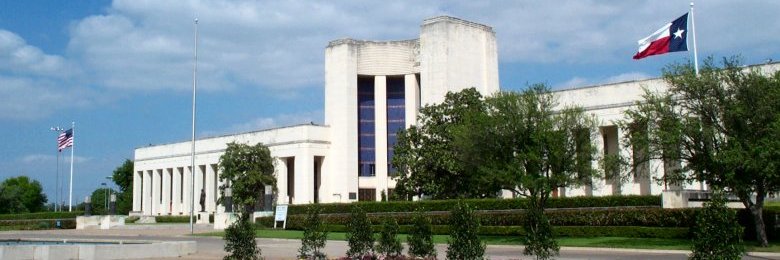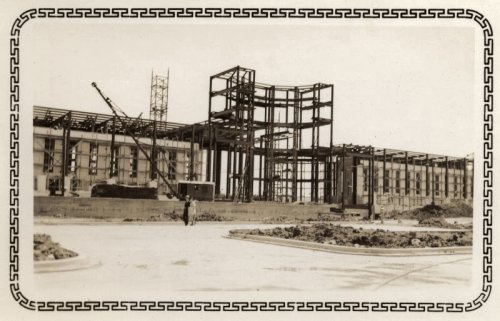|
|
Texas Hall of State

 Exterior |
 Great Hall |
 Hall of Heroes |
 North & South Texas Rooms |
 East & West Texas Rooms |
 Lower Level |
|
The Hall of State, without a doubt, is the grandest building standing in Fair Park, perhaps in all of Dallas (some might say in the whole State of Texas). It occupies a place of honor at the east end of the Esplanade and from its terrace visitors are afforded one of the most striking vistas in the park. On the terrace stands a statue of the man who was responsible for the grandeur his bronze image surveys. His name was R. L. "Bob" Thornton, Dallas banker, civic leader, mayor, and long-time president of the State Fair of Texas. It was Thornton who secured the Texas Centennial Exposition for Dallas, winning over cities like Houston, Austin, and San Antonio, all of which had more historical claim to the honor. Dallas, in fact, did not even exist at the time of the Texas Revolution). Spread out before "Uncle Bob" is the Esplanade, its open expanse measuring 300 feet across and a thousand feet in length. From this vantage point it is flanked on either side by the Automobile Building, to the left, and the Centennial Building on the right. In its center is a reflecting pool 70 feet wide by 700 feet in length. At night, with the Esplanade fountains illuminated and the gigantic statues bathed in soft blue lights, the view Bob Thornton's statue enjoys is breathtaking. Beyond the park can be seen the ever-changing skyline of Dallas, one that Thornton, who died several years ago, would no longer recognize.
The Hall of State is open daily (except Sundays, Mondays, and holidays) from 9 A.M. to 5 P.M. and on Sunday from 1 P.M. to 5 P.M.. Admission, except for special exhibits, is free. In 1938 after the Texas Centennial and Pan American Expositions had run their course, the State of Texas leased the building to the City of Dallas, which in turn gave custody of the Hall of State to the Dallas Historical Society. This arrangement continues to the present day except that in 1977 the building became City property. The Dallas Historical Society was founded in 1922 by one hundred and one of the city's citizens. It is a non-profit organization chartered by the State of Texas. Chief among its prominent early leaders was George Bannerman Dealey, vice-president and general manager of The Dallas Morning News, who was president of the D.H.S. from 1943 to 1946. The responsibility of the Dallas Historical Society, in its custodianship of one of the state's most important shrines, is to operate it as a history museum and research facility. This latter function it does very well, having on hand some 8,000 rare books, 13,000 artifacts, and numerous other items of interest to researchers. However, as a history museum it leaves a little to be desired. Due to lack of space, only a few of the artifacts from the society's collection are on display and only one of the wonderful miniature dioramas that were removed in 1987 during renovation of the Hall of State placed in storage is currently on display. |
Copyright © 1996-2012 by Steven Butler, Ph.D. All rights reserved.
 The Hall of State was constructed in 1936 at a cost of $1,200,000, a sum all the more remarkable for being spent during the middle of the Great Depression. Construction on this magnificent edifice began shortly after October 12, 1935, when Texas governor James V. Allred set off a dynamite blast at groundbreaking ceremonies. Unfortunately, due to delays on the interior decorations, the building was not ready to be opened when the Centennial Exposition began on Saturday, June 6, 1936. It was to be another three months before the Hall of State was ready to admit visitors on September 6, 1936. The wait, it appears, was worth it.
The Hall of State was constructed in 1936 at a cost of $1,200,000, a sum all the more remarkable for being spent during the middle of the Great Depression. Construction on this magnificent edifice began shortly after October 12, 1935, when Texas governor James V. Allred set off a dynamite blast at groundbreaking ceremonies. Unfortunately, due to delays on the interior decorations, the building was not ready to be opened when the Centennial Exposition began on Saturday, June 6, 1936. It was to be another three months before the Hall of State was ready to admit visitors on September 6, 1936. The wait, it appears, was worth it.